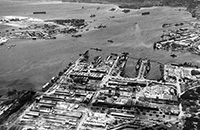Pearl Harbor Shipyard
Pearl Harbor Naval Shipyard is part of arguably the most famous Navy installation in the United States. The bombing of Pearl Harbor in 1941 brought the United States into World War II, but the facility's shipyard has another legacy. Since World War II, more than 10,000 workers were exposed to asbestos at Pearl Harbor.

The Navy’s Pearl Harbor Complex, shipyard included, is a Superfund cleanup site for the U.S. Environmental Protection Agency (EPA). Superfund is an EPA program geared towards cleaning up hazardous waste sites throughout the United States.
Asbestos remediation is still underway at Pearl Harbor, so current employees should be aware of the risks to avoid exposure.
Those previously exposed remain at risk of mesothelioma cancer.
In 2021, the International Journal of Environmental Health Research published a review. It found seafarers from Nordic countries have more than double the risk of developing mesothelioma.

Learn about your diagnosis, top doctors and how to pay for treatment.
Get Your Free GuideCurrent Condition
The shipyard is located within the Pearl Harbor Naval Station complex. The yard sits on 112 acres and contains 114 buildings and four dry docks. They provide full-service maintenance and technical support to the U.S. Navy in the greater Pacific.
The yard continues a modernization plan to create a safe and secure working environment for shipyard workers.
In July 2011, the U.S. Navy started the construction of a $15.8 million production services support facility near Dry Dock 1. The U.S. Navy has been renovating and rebuilding new structures constructed during World War II. The Navy has torn down 257 buildings in the past two decades and plans to demolish 121 more in the shipyard and throughout the entire complex.
In 2010, the Pacific Aviation Museum Pearl Harbor and the U.S. Navy signed a deal for the renovation of Ford Isle tower that could cost $10 million. Ken DeHoff, executive director of the museum, said asbestos was present in the ceiling and floor tiles of the facility.
Other structures in the shipyard contaminated with asbestos include:
- Building 1C: A three-story wooden office building built in 1942.
- The 171-stall lot and bus turnaround near USS Bowfin Submarine Museum and Park: During construction, contractors found broken-up asbestos sewer piping.
- The home of former Pacific Fleet Admiral Archie Clemins in Makalapa Crater: This structure was built in 1941.
Today, thanks to remediation and safety measures, the shipyard is much less toxic than in the past. People are still advised to take precautions with older building materials in the yard.
Recommended Reading


